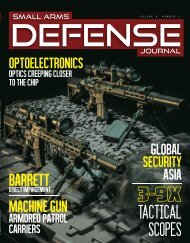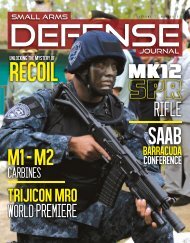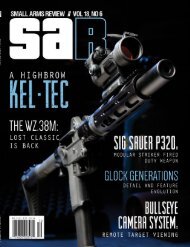SAR 20#2
You also want an ePaper? Increase the reach of your titles
YUMPU automatically turns print PDFs into web optimized ePapers that Google loves.
At high heat levels- those commonly encountered<br />
in military applications, 416<br />
can distort, lose its heat treated state,<br />
and even de-alloy—a condition where<br />
the additive materials lose their microscopic<br />
bonds to the iron/carbon structure.<br />
So this material, while in use, could<br />
become unsuitable or even unsafe. Not<br />
to worry—416R comes with a reliable<br />
programmed response to imminent failure.<br />
It will split like a banana peel before<br />
it fragments. This splitting action<br />
is resultant of the “stringers” as they’re<br />
called, the areas of sulfur that co-mingle<br />
in-between the regions of martensite<br />
(crystalline structures) in the metal alloy.<br />
There are other grades of stainless one<br />
might encounter in barrel making. 410,<br />
420 and 17-4 are less common, though<br />
they are found in use. 17-4 is renowned<br />
as a super alloy. It is fabled to get stronger<br />
from heat exposure. It has been said<br />
that it possesses mystical powers to<br />
“self-heal” micro fractures and surface<br />
defects. Few have ventured to deepdrill<br />
and cut rifling into a chunk of 17-4.<br />
Many have failed. The name Noveske<br />
will forever be remembered as one that<br />
succeeded. 17-4 is mainly used in pistol<br />
and revolver frames, muzzle devices,<br />
or small parts and even receivers and<br />
bolts of custom high-end high-power rifles.<br />
The last stainless worth mentioning<br />
here is 410 alloy. It is the underachiever<br />
of the bunch. The yield of this material is<br />
actually less than its intended operating<br />
threshold- a fact that some in the industry<br />
will argue. 30,000 PSI is where 410 can<br />
undergo “plastic deformation,” that is, be<br />
stressed past its ability to bounce back.<br />
Barrel makers still use this stuff knowing<br />
that a 5.56 NATO cartridge reaches<br />
over 60,000 psi just after ignition. Is this<br />
cause for alarm? Not really. Stress is<br />
calculated as a constant applied force.<br />
The pressure curve inside a gun barrel<br />
in not contained for any period of time,<br />
nor at a static load, but rather a burst<br />
that reaches a peak pressure. The pressure<br />
is not contained long enough or focused<br />
at a singular point where it could<br />
cause damage to the barrel. The barrel<br />
is saved by the fact that high pressure<br />
gas acts with equal force on all sides<br />
of its container (in this case the barrel)-<br />
and one side of the container (the bullet)<br />
is moving away from this applied force.<br />
So the bullet is effectively a valve that<br />
allows the pressure to escape. 410 alloy<br />
is said to be tougher and more abrasion<br />
resistant than 416. It is used by some<br />
manufactures to make gun barrels to<br />
save cost as it is imminently easy to<br />
machine. The more common stainless,<br />
416R does deliver on some promises.<br />
Many custom rifle builders who work<br />
for the competition market trust 416R.<br />
Countless benchrest, palma and F-class<br />
records have been claimed by guns fitted<br />
with barrels made from 416R. This<br />
material does in fact make for a perfect<br />
surface finish during machining. This<br />
perfect surface lends itself to superb accuracy.<br />
A barrel properly ‘smithed from<br />
416R will perform supremely, though<br />
not indefinitely. A match-grade stainless<br />
barrel fit to a high-powered competition<br />
rifle may be expected to have<br />
a good service life of 3000 rounds,<br />
more or less, depending somewhat on<br />
the caliber of the rifle, and largely on<br />
how it is cared for.<br />
Steel of any alloy may be encountered<br />
in a number of “states.” This refers<br />
to the condition of heat treatment it may<br />
have received. Annealed steel has been<br />
softened. This condition does not imply<br />
that the steel is mild- only that it has been<br />
reduced to a softer state to make it more<br />
workable. Hardened steel generally refers<br />
to a surface hardening to improve<br />
that steel’s wear resistance or reduce<br />
its frictional coefficient. This condition<br />
may also be called “case” hardened.<br />
Heat treated steel is generally hardened<br />
throughout, also known as “core” hard.<br />
Core hard is a condition commonly employed<br />
on high wear or high load components.<br />
Certain alloys are better suited<br />
<strong>SAR</strong> Vol. 20, No. 2 84 MARCH 2016









